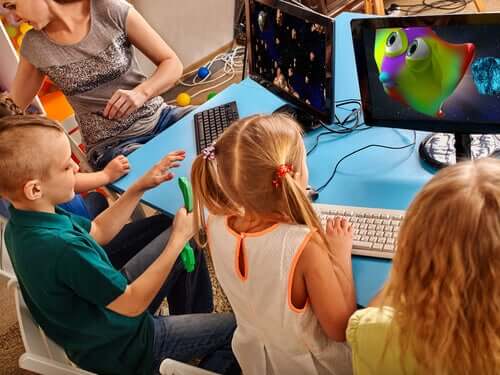3 Ways to Boost Creativity with Technology

Creativity is quickly becoming one of the most valued skills of the 21st century. According to a 2018 report by the World Economic Forum, it’s one of the three most sought-after skills that employers will look for by 2020. And there are many ways to boost creativity with technology.
In fact, an IBM survey revealed that 60% of CEO’s believe that creativity is the most important quality of leadership today. It’s a great tool that you have at your disposal. However, you may not use it as efficiently as possible with technology.
“Although sometimes people see technology as a distraction in educational settings or the workplace, it’s also true that it has great potential. It can help you think in new ways and create original ideas.”
If you want to know how to boost creativity with technology or make your students more creative every day, we’ll show you some ways to do it. It’s possible if you follow a few guidelines.
Boost creativity with technology by looking for the right distractions
Teachers often complain that technology can be a distraction. This is because it’s completely true. Yes, technology can be quite distracting. However, when it comes to being creative, research shows that distractions can be a good thing.

Neuroscientists from Harvard University and University of Toronto conducted a study, which found that people with low ability to avoid distractions tend to have a much richer mix of creative thoughts. In short, distractions can be good.
If you want to create useful ideas, both people who can’t avoid distractions and people that concentrate well need to learn how to let themselves get carried away by distractions. However, they need to learn how to tune into the “right” distractions.
In this sense, you need to guide your students. If they’re distracted by technology, which is highly probable, they should do it the right way. They need to choose distractions that teach them something, or inspire them for what they want to work on.
Be open to new things
Things aren’t always going to stay the same, and they can change. In technology, this is also true. However, when things change, it can make people feel uncomfortable. An important characteristic of creative people is the ability to be open to new experiences, opportunities and ideas.
One day, some website that your students usually use in class will change and look different. Then, you can use that moment to show how positive change is. If they’re reluctant to change at first, it’s your job to teach them how to be open to new things.
Smooth the line between learning and playing to boost creativity with technology
Softening the line between learning and playing is something that also helps boost creativity with technology. Understanding that work and fun aren’t mutually exclusive is key to feeling balanced between school and real life.
Once students accept and understand that they can have fun while learning, they’ll be more open to new ways of thinking and creating. In addition, they’ll learn that they can have bright ideas related to what they’re learning, even during their free time.

“Instead of approaching technology with an attitude of ‘this is school, and this is play,’ we should look for ways to learn in a playful way.”
Research shows that the creative process tends to involve a period of alone time or “incubation.” During this time, your thoughts can flow freely. In addition, students will have lots of ideas: some good, some bad, but they need to have space to figure it out.
In conclusion, you need to use technology to boost creativity both individually and in groups. You can do this by sharing spaces and creating your own personal space. It’s very important to find the right balance to be the most effective.
Creativity is quickly becoming one of the most valued skills of the 21st century. According to a 2018 report by the World Economic Forum, it’s one of the three most sought-after skills that employers will look for by 2020. And there are many ways to boost creativity with technology.
In fact, an IBM survey revealed that 60% of CEO’s believe that creativity is the most important quality of leadership today. It’s a great tool that you have at your disposal. However, you may not use it as efficiently as possible with technology.
“Although sometimes people see technology as a distraction in educational settings or the workplace, it’s also true that it has great potential. It can help you think in new ways and create original ideas.”
If you want to know how to boost creativity with technology or make your students more creative every day, we’ll show you some ways to do it. It’s possible if you follow a few guidelines.
Boost creativity with technology by looking for the right distractions
Teachers often complain that technology can be a distraction. This is because it’s completely true. Yes, technology can be quite distracting. However, when it comes to being creative, research shows that distractions can be a good thing.

Neuroscientists from Harvard University and University of Toronto conducted a study, which found that people with low ability to avoid distractions tend to have a much richer mix of creative thoughts. In short, distractions can be good.
If you want to create useful ideas, both people who can’t avoid distractions and people that concentrate well need to learn how to let themselves get carried away by distractions. However, they need to learn how to tune into the “right” distractions.
In this sense, you need to guide your students. If they’re distracted by technology, which is highly probable, they should do it the right way. They need to choose distractions that teach them something, or inspire them for what they want to work on.
Be open to new things
Things aren’t always going to stay the same, and they can change. In technology, this is also true. However, when things change, it can make people feel uncomfortable. An important characteristic of creative people is the ability to be open to new experiences, opportunities and ideas.
One day, some website that your students usually use in class will change and look different. Then, you can use that moment to show how positive change is. If they’re reluctant to change at first, it’s your job to teach them how to be open to new things.
Smooth the line between learning and playing to boost creativity with technology
Softening the line between learning and playing is something that also helps boost creativity with technology. Understanding that work and fun aren’t mutually exclusive is key to feeling balanced between school and real life.
Once students accept and understand that they can have fun while learning, they’ll be more open to new ways of thinking and creating. In addition, they’ll learn that they can have bright ideas related to what they’re learning, even during their free time.

“Instead of approaching technology with an attitude of ‘this is school, and this is play,’ we should look for ways to learn in a playful way.”
Research shows that the creative process tends to involve a period of alone time or “incubation.” During this time, your thoughts can flow freely. In addition, students will have lots of ideas: some good, some bad, but they need to have space to figure it out.
In conclusion, you need to use technology to boost creativity both individually and in groups. You can do this by sharing spaces and creating your own personal space. It’s very important to find the right balance to be the most effective.
All cited sources were thoroughly reviewed by our team to ensure their quality, reliability, currency, and validity. The bibliography of this article was considered reliable and of academic or scientific accuracy.
- World Economic Forum. The Future of Jobs Report 2018. Cologny/Geneva – Switzerland.
- Navarro Lozano, Juan. (2008). Mejora de la creatividad en el aula de primaria. Diss. Universidad de Murcia.
- Fisher, Robert. (2013). El diálogo creativo en el aula. Ediciones Morata, 2013.
This text is provided for informational purposes only and does not replace consultation with a professional. If in doubt, consult your specialist.








